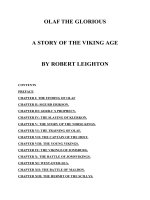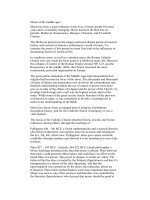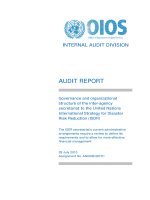Dawn of the dinosaur age
Bạn đang xem bản rút gọn của tài liệu. Xem và tải ngay bản đầy đủ của tài liệu tại đây (5.96 MB, 161 trang )
DAWN OF THE
DINOSAUR AGE
THE LATE TRIASSIC &
EARLY JURASSIC EPOCHS
Dawn of Dinosaur_dummy.indd 1
7/17/08 1:16:01 PM
THE PREHISTORIC EARTH
Early Life:
The Cambrian Period
The First Vertebrates:
Oceans of the Paleozoic Era
March Onto Land:
The Silurian Period to the Middle Triassic Epoch
Dawn of the Dinosaur Age:
The Late Triassic & Early Jurassic Epochs
Time of the Giants:
The Middle & Late Jurassic Epochs
Last of the Dinosaurs:
The Cretaceous Period
The Rise of Mammals:
The Paleocene & Eocene Epochs
The Age of Mammals:
The Oligocene & Miocene Epochs
Primates and Human Ancestors:
The Pliocene Epoch
Early Humans:
The Pleistocene & Holocene Epochs
16280_PE_Dino_5p_all.e.indd 2
7/3/08 12:12:25 PM
DAWN OF THE
DINOSAUR AGE
THE LATE TRIASSIC &
EARLY JURASSIC EPOCHS
Thom Holmes
Dawn of Dinosaur_dummy.indd 3
7/17/08 1:16:03 PM
THE PREHISTORIC EARTH: Dawn of the Dinosaur Age
Copyright © 2008 by Infobase Publishing
All rights reserved. No part of this book may be reproduced or utilized in any form or by any
means, electronic or mechanical, including photocopying, recording, or by any information storage
or retrieval systems, without permission in writing from the publisher. For information, contact:
Chelsea House
An imprint of Infobase Publishing
132 West 31st Street
New York NY 10001
Library of Congress Cataloging-in-Publication Data
Holmes, Thom.
Dawn of the dinosaur age / Thom Holmes.
p. cm. — (The prehistoric Earth)
Includes bibliographical references and index.
ISBN 978-0-8160-5960-7 (hardcover)
1. Dinosaurs—Study and teaching—United States. 2. Fossils—Study and teaching—United States.
3. Geology, Stratigraphic—Mesozoic. I. Title. II. Series.
QE861.4.H65 2008
567.9—dc22
2007045331
Chelsea House books are available at special discounts when purchased in bulk quantities for
businesses, associations, institutions, or sales promotions. Please call our Special Sales Department
in New York at (212) 967-8800 or (800) 322-8755.
You can find Chelsea House on the World Wide Web at
Text design by Kerry Casey
Cover design by Salvatore Luongo
Section opener images © John Sibbick
Printed in the United States of America
Bang NMSG 10 9 8 7 6 5 4 3 2 1
This book is printed on acid-free paper.
All links and Web addresses were checked and verified to be correct at the time of publication.
Because of the dynamic nature of the Web, some addresses and links may have changed since
publication and may no longer be valid.
Dawn of Dinosaur_dummy.indd 4
7/17/08 1:16:03 PM
CONTENTS
Preface
Acknowledgments
Foreword
Introduction
6
9
11
13
Section One: The World of the Dinosaurs
Chapter 1 The Mesozoic World
Chapter 2 Archosaurs:
The Ruling Reptiles
Chapter 3 Dinosaur Origins
Section Two: Dinosaurs of the Early
Mesozoic Era
Chapter 4 Predatory Saurischian
Dinosaurs: The Theropods
Chapter 5 Herbivorous Saurischian
Dinosaurs: The Sauropodomorpha
Chapter 6 Early Ornithischian Dinosaurs
17
19
Conclusion
Appendix One: Geologic Time Scale
Appendix Two: Anatomical Directions
Glossary
Chapter Bibliography
Further Reading
Picture Credits
Index
About the Author
26
51
71
72
104
123
132
135
136
137
142
148
152
153
159
5
16280_PE_Dino_5p_all.e.indd 5
7/3/08 12:12:30 PM
PREFACE
To be curious about the future, one must know something about
the past.
Humans have been recording events in the world around them
for about 5,300 years. That is how long it has been since the Sumerian people, in a land that today is southern Iraq, invented the first
known written language. Writing allowed people to document what
they saw happening around them. The written word gave a new
permanency to life. Language, and writing in particular, made history possible.
History is a marvelous human invention, but how do people
know about things that happened before language existed? Or
before humans existed? Events that took place before human record
keeping began are called prehistory. Prehistoric life is, by its definition, any life that existed before human beings existed and were able
to record for posterity what was happening in the world around
them.
Prehistory is as much a product of the human mind as history.
Scientists who specialize in unraveling clues of prehistoric life are
called paleontologists. They study life that existed before human
history, often hundreds of thousands and millions of years in the
past. Their primary clues come from fossils of animals and plants
and from geologic evidence about Earth’s topography and climate.
Through the skilled and often imaginative interpretation of fossils, paleontologists are able to reconstruct the appearance, lifestyle, environment, and relationships of ancient life-forms. While
paleontology is grounded in a study of prehistoric life, it draws on
many other sciences to complete an accurate picture of the past.
Information from the fields of biology, zoology, geology, chemistry,
6
16280_PE_Dino_5p_all.e.indd 6
7/3/08 12:12:31 PM
Preface
7
meteorology, and even astrophysics is called into play to help the
paleontologist view the past through the lens of today’s knowledge.
If a writer were to write a history of all sports, would it be enough
to write only about table tennis? Certainly not. On the shelves of
bookstores and libraries, however, we find just such a slanted perspective toward the story of the dinosaurs. Dinosaurs have captured
our imagination at the expense of many other equally fascinating,
terrifying, and unusual creatures. Dinosaurs were not alone in the
pantheon of prehistoric life, but it is rare to find a book that also
mentions the many other kinds of life that came before and after
the dinosaurs.
The Prehistoric Earth is a series that explores the evolution of life
from its earliest forms 3.5 billion years ago until the emergence of
modern humans some 300,000 years ago. Four volumes in the series
trace the story of the dinosaurs. Six other volumes are devoted to
the kinds of animals that evolved before, during, and after the reign
of the dinosaurs. The Prehistoric Earth covers the early explosion of
life in the oceans; the invasion of the land by the first land animals;
the rise of fishes, amphibians, reptiles, mammals, and birds; and the
emergence of modern humans.
The Prehistoric Earth series is written for readers in high school.
Based on the latest scientific findings in paleontology, The Prehistoric Earth is the most comprehensive and up-to-date series of its
kind for this age group.
The first volume in the series, Early Life, offers foundational
information about geologic time, Earth science, fossils, the classification of organisms, and evolution. This volume also begins
the chronological exploration of fossil life that explodes with the
incredible life-forms of Precambrian times and the Cambrian
Period, more than 500 million years ago.
The remaining nine volumes in the series can be read chronologically. Each volume covers a specific geologic time period and
describes the major forms of life that lived at that time. The books
also trace the geologic forces and climate changes that affected the
16280_PE_Dino_5p_all.e.indd 7
7/3/08 12:12:32 PM
8
DAWN OF THE DINOSAUR AGE
evolution of life through the ages. Readers of The Prehistoric Earth
will see the whole picture of prehistoric life take shape. They will
learn about forces that affect life on Earth, the directions that life
can sometimes take, and ways in which all life-forms depend on
each other in the environment. Along the way, readers also will
meet many of the scientists who have made remarkable discoveries
about the prehistoric Earth.
The language of science is used throughout this series, with
ample definition and with an extensive glossary provided in each
volume. Important concepts involving geology, evolution, and the
lifestyles of early animals are presented logically, step by step. Illustrations, photographs, tables, and maps reinforce and enhance the
books’ presentation of the story of prehistoric life.
While telling the story of prehistoric life, the author hopes that
many readers will be sufficiently intrigued to continue studies
on their own. For this purpose, throughout each volume, special
“Think About It” sidebars offer additional insights or interesting
exercises for readers who wish to explore certain topics. Each book
in the series also provides a chapter-by-chapter bibliography of
books, journals, and Web sites.
Only about one-tenth of 1 percent of all species of prehistoric
animals are known from fossils. A multitude of discoveries remain
to be made in the field of paleontology. It is with earnest, best wishes
that I hope that some of these discoveries will be made by readers
inspired by this series.
—Thom Holmes
Jersey City, New Jersey
16280_PE_Dino_5p_all.e.indd 8
7/3/08 12:12:33 PM
ACKNOWLEDGMENTS
I would like to thank the many dedicated and hardworking people
at Chelsea House. A special debt of gratitude goes to my editors,
Shirley White, Brian Belval, and Frank Darmstadt, for their support and guidance in conceiving and making The Prehistoric Earth
a reality. Frank and Brian were instrumental in fine-tuning the features of the series as well as accepting my ambitious plan for creating a comprehensive reference for students. Brian greatly influenced
the development of the color-illustration program and supported
my efforts to integrate the work of some of the best artists in the
field, most notably John Sibbick, whose work appears throughout
the set. Shirley’s excellent questions about the science behind the
books contributed greatly to the readability of the result. The excellent copyediting of Mary Ellen Kelly was both thoughtful and vital
to shaping the final manuscript. I thank Mary Ellen for her patience
as well as her valuable review and suggestions that help make the
books a success.
I am privileged to have worked with some of the brightest minds
in paleontology on this series. Jerry D. Harris, the director of paleontology at Dixie State College in St. George, Utah, reviewed the
draft of Dawn of the Dinosaur Age and made many important suggestions that affected the course of the work. Jerry also wrote the
Foreword for the volume.
In many ways, a set of books such as this requires years of preparation. Some of the work is educational, and I owe much gratitude to
Dr. Peter Dodson of the University of Pennsylvania for his gracious
and inspiring tutelage over the years. Another dimension of preparation requires experience digging fossils, and for giving me these
opportunities I thank my friends and colleagues who have taken
me into the field with them, including Phil Currie, Rodolfo Coria,
9
16280_PE_Dino_5p_all.e.indd 9
7/3/08 12:12:34 PM
10
DAWN OF THE DINOSAUR AGE
Matthew Lammana, and Ruben Martinez. Finally comes the work
needed to put thoughts down on paper and complete the draft of a
book, a process that always takes many more hours than I plan on.
I thank Anne for bearing with my constant state of busy-ness and
for helping me remember the important things in life. You are an
inspiration to me. I also thank my daughter, Shaina, the genius in
the family and another inspiration, for always being supportive and
humoring her father’s obsession with prehistoric life.
16280_PE_Dino_5p_all.e.indd 10
7/3/08 12:12:35 PM
FOREWORD
Life is change. As clichéd—and, perhaps, oversimplistic—as this
sounds, it is still a fact; and nowhere is this fact better expressed
than in the fossil record, the only record we have of how and when
life underwent change in the deep past. Paleontologists are scientists dedicated to documenting and deciphering the fossil record to
see how and why life has changed through time. By doing so, they
establish our understanding of how life responds to environmental
changes and our knowledge of what limits that change—issues that
are critical to humans today as we begin to see significant changes
in our modern world’s climate.
Thus, to try to understand the history of life on Earth is not
simply a pointless pastime; it is an important scientific pursuit. Our
understanding of life’s past diversity has become so good, however,
that it is easy to get lost in the abundance of information available.
This series, The Prehistoric Earth, is a terrific place to begin for
anyone with curiosity about the history of life on Earth, even if that
person never becomes a degreed scientist. Regardless of what kinds
of fossil organisms interest someone, this series has something for
that person and will help him or her to understand what the ancient
world was like at different points in time.
Paleontology is an interesting science. It is actually a combination
of many sciences, predominantly Earth science (geology) and life
science (biology), but it also requires a good amount of chemistry,
physics, and even astronomy. This may be why paleontologists are
hard to place in universities—at some, they are in geology departments; in others, they are in biology departments. Fortunately,
Thom Holmes melds these seemingly disparate sciences together
in The Prehistoric Earth. He provides excellent summaries that
will open doors for further investigation by all interested readers.
11
16280_PE_Dino_5p_all.e.indd 11
7/3/08 12:12:36 PM
12
DAWN OF THE DINOSAUR AGE
If this is the first book in the series that you are reading, I heartily
recommend that you read the others, too; they will help you to put
everything in the best possible context.
The book you now are reading, Dawn of the Dinosaur Age,
explores one of the most important times in Earth history: the beginning of the Mesozoic Era. The book emphasizes the recovery of life,
during the Triassic Period, from the massive extinction event—the
largest in Earth’s history—that brought the Paleozoic Era to a close.
As life expanded into the myriad ecological niches emptied by the
extinction event, it produced, by the end of the Triassic, all the
major “players” that still dominate the world today: the first turtles,
crocodylomorphs, mammals, and—perhaps most evocatively and
famously—dinosaurs. How dinosaurs evolved is a fascinating story.
It is not often told outside the technical, scientific literature and is
rarely as up to date as Thom Holmes has told it here. So sit back and
enjoy. You are about to learn about a wide variety of spectacular and
bizarre organisms. Many of them you probably never have heard of
before, but you will not soon forget them.
—Dr. Jerry D. Harris
Director of Paleontology
Dixie State College
St. George, Utah
16280_PE_Dino_5p_all.e.indd 12
7/3/08 12:12:37 PM
INTRODUCTION
The evolution and diversification of the first organisms on Earth
progressed even in the face of tumultuous changes to the planet
and devastating events leading to several mass extinctions. Life
in the Paleozoic Era was marked by large-scale changes to geology
and climate. Those who study the history of life view the end of the
Paleozoic as a kind of curtain being drawn on evolution’s first great
span of “experiments.” Striking Earth’s stage with a bang, the mass
extinction at the end of the Paleozoic almost left that stage utterly
empty of life. Life in every region of the globe—in the sea, in lakes
and streams, and on land—nearly perished entirely. The end of the
Paleozoic also marked the beginning of a new span in the history of
life, the evolution of modern flora and fauna with often-distant but
direct links to organisms alive today.
Vertebrates in the sea and on the land emerged from the devastating effects of the end-Permian mass extinction diminished but
on the rebound. Dawn of the Dinosaur Age presents the first act in
the drama that would become the Mesozoic Era, the sorting out of
various terrestrial (land-based) fauna, and the introduction of the
first dinosaurs as the leading actors of the new world.
OVERVIEW OF DAWN OF THE DINOSAUR AGE
Dawn of the Dinosaur Age begins, in Section One, by looking at the
geological and climatic aftermath of the end-Permian extinction
and the conditions of the early Mesozoic Era that created opportunities for archosaurian vertebrates, including dinosaurs. Chapter 1
describes the widespread changes to ocean and land environments,
including worldwide changes to climates that served as catalysts for
the spread of the archosaurs. Among these changes was another
important set of mass-extinction events at the end of the Triassic
13
16280_PE_Dino_5p_all.e.indd 13
7/3/08 12:12:38 PM
14
DAWN OF THE DINOSAUR AGE
Period. Chapter 2 introduces the archosaurs of the Early Triassic
that led to the rise of the dinosaurs and their relatives. In Chapter 3,
the earliest dinosaurs are described, along with reasons for their
rapid rise to a position of dominance over many other animals of
the Mesozoic Era. Was their success due to good luck, or to better
genes?
Section Two, Dinosaurs of the Early Mesozoic Era, introduces the
major groups of dinosaurs. Chapter 4 presents the two major divisions of dinosaurs: the Saurischia, or “lizard-hipped” dinosaurs,
and the Ornithischia, or “bird-hipped” dinosaurs. The chapter
then goes on to look closely at the carnivorous saurischian dinosaurs: their traits, their lifestyles, and the earliest examples of their
kind. Chapter 5 describes the early evolution of the other major
clade of saurischians, the giant, long-necked herbivores. The chapter explores their early evolution, their traits, and the adaptations
that led to their great success. Chapter 6 describes the origin and
traits of the earliest members of the Ornithischia, the other major
dinosaur clade, which consisted of diverse plant eaters.
Each chapter uses tables, maps, figures, and photos to depict
the life, habitat, and changing evolutionary patterns that affected
the lives of the early dinosaurs and their kin. Several chapters also
include “Think About It” sidebars that elaborate on interesting
issues, people, and discoveries related to Mesozoic life.
Dawn of the Dinosaur Age builds on foundational principles of
geology, fossils, and the study of life. Readers who want to refresh
their knowledge of certain basic terms and principles in the study
of past life—or who seek to learn those principles for the first
time—may wish to consult the glossary in the back of Dawn of the
Dinosaur Age. Perhaps most important to keep in mind are the
basic rules governing evolution: The direction of evolution is set
in motion first by the genetically determined traits inherited by
individuals, coupled with the interaction of that individual with its
habitat. Changes accumulate, generation after generation, and allow
species to adapt to changing conditions in the world around them.
As Charles Darwin (1809–1882) explained, “The small differences
16280_PE_Dino_5p_all.e.indd 14
7/3/08 12:12:40 PM
Introduction
15
distinguishing varieties of the same species steadily tend to increase,
till they equal the greater differences between species of the same
genus, or even of distinct genera.” These are the rules of nature that
drove the engine of evolution during the Paleozoic and gave rise to
forms of life whose descendants still populate the Earth.
16280_PE_Dino_5p_all.e.indd 15
7/3/08 12:12:40 PM
Page 16
Blank
16280_PE_Dino_5p_all.e.indd 16
7/3/08 12:12:40 PM
SECTION ONE:
THE WORLD
OF THE DINOSAURS
16280_PE_Dino_5p_all.e.indd 17
7/3/08 12:12:41 PM
Page 18
Blank
16280_PE_Dino_5p_all.e.indd 18
7/3/08 12:12:58 PM
1
THE MESOZOIC WORLD
The end-Permian mass extinction marked a significant milestone
in the history of life. It signaled a passing from the Paleozoic Era,
the time of ancient organisms, to the Mesozoic Era, the time of
“middle life.” Placed squarely at the helm of planet Earth were the
reptiles, whose ascendancy was already assured as the Permian
Period came to a close. Not all lines of Paleozoic reptiles survived
to cross the timeline into the Mesozoic, but their numbers and
diversity were such that several key groups lived to propagate distinctive groups of reptiles that would dominate life in every major
habitat.
The Mesozoic Era is divided into three periods of time. It begins with the Triassic, moves to the middle or Jurassic Period, and
concludes with the Cretaceous Period. These periods are further
divided into smaller spans, all of which are shown, along with
major milestones, in the table below that outlines the evolution of
Mesozoic vertebrates. Mass extinctions are also noted in the following table to illustrate how new species evolve to occupy niches left
vacant by extinct species. The Mesozoic Era spanned 180 million
years, and dinosaurs ruled over terrestrial life for nearly 160 million
of those years.
During the Mesozoic Era, gradual changes in Earth’s tectonic
plates modified land and ocean habitats. This affected the world’s
many life-forms. This chapter examines the geologic and climatic
conditions that influenced the evolution of the flora and fauna of
the days of the dinosaurs.
19
16280_PE_Dino_5p_all.e.indd 19
7/3/08 12:12:58 PM
20
DAWN OF THE DINOSAUR AGE
EVOLUTIONARY MILESTONES OF THE MESOZOIC ERA
Span
(millions of
years ago)
Duration
(millions
of years)
Early Triassic
251–245
6
Diversification and distribution of
amniotes, particularly synapsid and
diapsid reptiles
Middle Triassic
245–228
17
Rise of pterosaurs and euryapsid
marine reptiles
Late Triassic
228–200
28
Early dinosaurs and mammals
Period
Triassic
Epoch
Mass extinction
Jurassic
Cretaceous
Organismal Milestones
Casualties: dicynodonts, carnivorous
cynodonts, phytosaurs, placodonts,
nothosaurs
Early Jurassic
200–175
25
Radiation of carnivorous and
herbivorous dinosaurs; first crocodiles
Middle Jurassic
175–161
14
Rise of armored and plated dinosaurs;
rise of sauropods
Late Jurassic
161–145
16
Diversification of sauropods; the
theropods; the first birds
Early Cretaceous
145–100
45
Continued diversification of
dinosaurs, marine reptiles, and
pterosaurs
Late Cretaceous
100–65.5
35
Rise of large theropods, horned
dinosaurs, hadrosaurs
Mass extinction
Casualties: dinosaurs, marine reptiles,
pterosaurs
RESHAPING OF THE CONTINENTS
AND OCEANS
The Earth underwent dramatic geologic changes during the 180
million-year span of the Mesozoic Era. During most of the Triassic Period, the continents that are known today were still joined
together as the supercontinent Pangaea. Pangaea was an expansive landmass that filled most of the Earth’s Western Hemisphere.
Because of Pangaea’s size, distinct interior climate zones and
new habitats for plants and animals developed. The formation of
Pangaea also marked a low ebb in ocean depths; this was one of
Dawn of Dinosaur_dummy.indd 20
7/17/08 1:16:05 PM
The Mesozoic World
21
the factors that contributed to the changes in ocean habitats that
led to the end-Permian extinction of many marine invertebrate
species.
By the Early Jurassic, Pangaea began to split apart, first dividing
into two landmasses. The northern landmass, which geologists call
Laurasia, included areas that later became North America, Europe,
and Asia. The southern landmass, known as Gondwana, included
the regions now known as South America, Africa, India, Australia,
and Antarctica. Further division into the present configuration of
the world’s continents was well under way by the end of the Mesozoic Era.
If the formation of Pangaea could be called the signature
geologic event of the Paleozoic, then the gradual breakup of the
supercontinent could be called the most influential geologic occurrence of the Mesozoic. Massive shifts in tectonic plates were
not without their consequences for many of the world’s habitats.
While Pangaea was intact, it was surrounded by the Panthalassic
Ocean, the southeastern portion of which was called the Tethys
Ocean. The Atlantic Ocean began
to appear in the middle of Pangaea as tectonic plates separated
and continental landmasses radiated outward from the equator to
the north and south. The collision
of tectonic plates began the formation of North America. Continental areas today associated with
North and South America, Europe, central Asia, and northern
Africa were the site of extensive
inland seas. By the Cretaceous Period, North America had a shallow inland sea stretching down its
middle from what is now Alaska
Pangaea during the Triassic Period
to the Gulf of Mexico.
16280_PE_Dino_5p_all.e.indd 21
7/3/08 12:12:59 PM
22
DAWN OF THE DINOSAUR AGE
CLIMATES AND HABITATS
The world of the Mesozoic was evenly temperate in climate over
most of the globe. Unlike the second half of the Paleozoic, during which the most habitable landmasses consisted of tropical rain
forests on either side of the equator, the spreading of the continents
northward and southward during the Mesozoic was accompanied
by climate changes. These changes led to a moderately warm but
drier environment during most of the Mesozoic. One reason for this
moderating of global temperature was the breakup of Pangaea itself.
The division of the giant landmass into smaller continents made all
land more susceptible to temperature changes moderated by ocean
currents. During the Mesozoic, Earth was covered by more water
than had covered it during the latter stages of the Paleozoic, and
there were no massive ice caps at the poles. Because water is a tremendous sponge for solar radiation, the oceans became warm, and
ocean currents distributed heat to the north and to the south. This
distribution provided a more evenly temperate world climate than
had existed in the previous era.
Fossil evidence of nontropical plants distributed all over the
globe and the lack of any evidence for glaciation support the likelihood that the climate of the Mesozoic was pleasantly mild. Lands
that are now known to be extremely cold to the north—such as
Greenland and northern Europe—once hosted such mild-climate
plants as ginkgo and conifer trees. None of these plants could have
survived subfreezing temperatures on a regular basis.
Analysis of the oxygen-isotope content—a direct indicator of
climate—of Mesozoic marine fossils provides additional support for
a temperate world climate. Samples taken from locations in North
America, Europe, and Russia show that the temperature of shallow
marine environments ranged from 60°F to 75°F (15°C to 24°C), making for a relatively warm day at the Mesozoic beach most of the time.
By the Late Mesozoic, the world’s dry, temperate climate had
become more humid in some locations, such as ancient North
America. This was partly due to the fact that a warm, shallow sea
ran down the middle of the continent. This inland sea provided
16280_PE_Dino_5p_all.e.indd 22
7/3/08 12:13:00 PM
The Mesozoic World
23
continually large volumes of evaporation and periodic downpours
of rain to support a robust recycling of atmospheric moisture.
MASS EXTINCTIONS OF THE
LATE TRIASSIC EPOCH
The end-Permian mass extinction nearly wiped out all life on the
planet. Those animals that stumbled into the Triassic Period and
the era of “middle life” required 10 million years to return to previous levels of diversity. Marine animals and coral reefs took even
longer to recover. Many families of plants survived the end-Permian
extinction in relatively good numbers, but gradual changes in climate and habitats saw the once-dominant broadleaf seed ferns and
cordaites replaced by conifers, cycads, ginkgoes, and spore-bearing
plants such as club mosses, ferns, and horsetails. The dominant
land animals of the Early to Middle Triassic were the rhynchosaurs, dicynodonts, and cynodonts, many of which had successfully
migrated to the farthest corners of Pangaea prior to its gradual
breakup into small landmasses.
The newfound stability of the Early to Middle Triassic did not
last. Between 228 million and 199.6 million years ago, in the Late
Triassic Epoch, two more mass-extinction events laid waste large
numbers of animals and plants. Among those devastated were the
fiercest predators and largest herbivores of the time, including the
rhynchosaurs, most dicynodonts and cynodonts, and even some
archosaurs. Plants also suffered greatly: The newly dominant seed
ferns—including conifers, cycads, and ginkgoes—and the sporebearing club mosses were nearly wiped out and supplanted by other
conifers, larger cycads, and surviving mosses. These extinctions
have been blamed on climate shifts, the first of which may have
been caused by a likely asteroid impact, as evidenced by the 43-mile
(70 km) diameter Manicouagan Crater in Quebec, Canada.
Curiously, the Late Triassic extinctions coincided with the appearance of the first dinosaurs—an association that is the subject of
much scientific debate that will be explored in Chapter 3. Chapter 2
explores the rise of the archosaurs, or “ruling reptiles,” and the likely
reasons for their early success.
16280_PE_Dino_5p_all.e.indd 23
7/3/08 12:13:00 PM
24
DAWN OF THE DINOSAUR AGE
Late Traissic landscape
SUMMARY
This chapter examined the geologic and climatic conditions that
influenced the evolution of the flora and fauna of the days of the
dinosaurs.
1. The end-Permian mass extinction marked the passage from
the Paleozoic Era of “ancient life” to the beginning of the
Mesozoic Era of “middle life.”
2. The Mesozoic Era is divided into three major time spans:
the Triassic Period, the Jurassic Period, and the Cretaceous
Period.
16280_PE_Dino_5p_all.e.indd 24
7/3/08 12:13:01 PM









